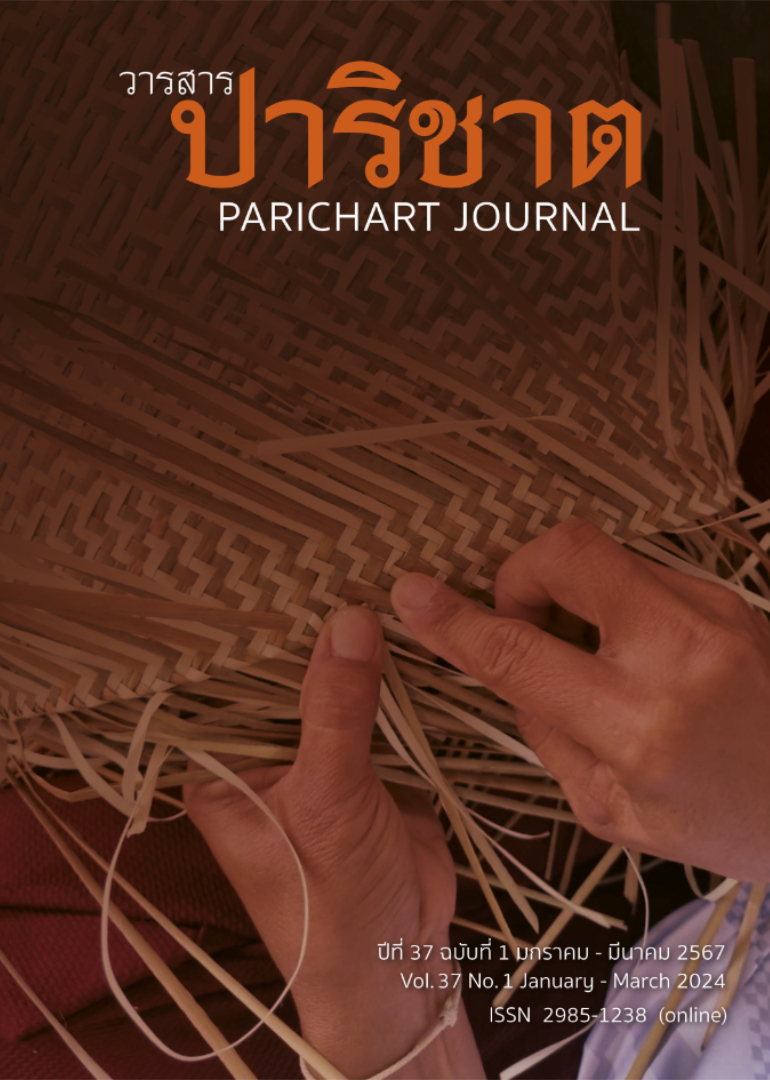Production Process Innovation for Pineapple Fiber Product Development
Main Article Content
Abstract
The objectives of this research were to 1) develop prototype products from pineapple fiber and 2) test satisfaction of prototype products made from pineapple fibers. This research used a mixed research method combining quantitative research with a participatory action research. A focus group was arranged to brainstorm ideas and suggestions on home decoration items made of pineapple fibers. The participants included 41 stakeholders from public and private sectors as well as those of a future target group. Concerning collection of data on market testing, it was undertaken by using online questionnaires. There were 4 aspects in the questionnaires: function, beauty, price, and sentimental value. 325 respondents included 22 foreigners and 303 Thais. For data analysis, they were frequency, percentage, mean, and standard deviation. The findings derived from the brainstorming revealed it should increase value adding to other aspects, in addition to pineapple fibers. This could be done, for example, through creating product concepts, creating various products based on customers’ age range, using other products to create stories or to encourage their uniqueness. For instance, for the products that showed community identity, a set of 5 products used for home decoration were created: a vase, a lamp, a curtain, a wallpaper and a set of placemats and glass coasters. Regarding the satisfaction data of the target customer groups, all product types were rated at high levels ranging from 3.88 – 4.38 with the standard deviation from 0.42 – 0.60.
Article Details

This work is licensed under a Creative Commons Attribution-NonCommercial-NoDerivatives 4.0 International License.
References
Krungthai COMPASS. (2018). Green furniture and eco-friendly furniture. Thailand plus TV Documentary Magazine. https://www.thailandplus.tv/archives/648224
Trade Policy and Strategy Office. (2022). Strategic proposals to drive product exports under the BCG Model.https://tpso.go.th/document/2306-0000000087
Bangkok Business. (2020, January 2). Get to know bcg economy the new model of the thai economy. https://www.bangkokbiznews.com/business/859943.
Surawattanawises, W., Chonsakorn, S., Mongkholrattanasit, R., & Nakhon, P. (2018). Physical properties of pineapple fiber and mechanical testing for scrub pads application. SDU Research Journal, 10(3),87–102.
Mohanty, A. K.., Misra, M., & Hinrichsen, G. (2000). Biofibres, biodegradable polymers and biocomposites. Journal Metrics: Macromolecular Materials and Engineering, 276-277, 1-24.
Pineapple leaf fibers from industrial textiles. (2021, April 02). KMUTT Library. https://kmuttlibrary.medium.com/AD-pineapple-leaf-fibers-from-industrial-textiles-dc51e7214a64
Chitchakkol, N., & Suthasini, B. (2022). The process of applying pineapple fibers to product design. Proceedings of 15th National and International Conference, 2022(438-449)
Chankaew, S., Seo, M., & Khieomang, K. (2019). Craftsmanship of sugarcane fiber yarn to produce home textile products. Burapha Arts Journal, 22(1), 52-64.
Wongsarawit, P. (2018, June 5). Circular Economy. https://www.prachachat.net/columns/news-169313.
Cooper, L. P. (2003). A research agenda to reduce risk in new product development through knowledge management: a practitioner perspective. Journal of Engineering and Technology Management, 20(1-2) 2003.DOI:10.1016/S0923-4748(03)00007-9
Keawpan, T., Itsaranuwat, S., & Plangnok, J. (2020). Principles and concepts in product design. Journal of Humanities and Social Sciences Surin Rajabhat University, 22(2), 161-182.
Bamrungjit, K. (2019). Knowledge management and research innovation in promoting pineapple fiber weaving product processing and product branding and commercial websites to build a career and rich income and sustainable for the nong phanchan subdistrict community, ban kha district, Ratchaburi province. Rajamangala University of Technology Phra Nakhon.
Srivorradatpaisan, S., Hiaomang, K., & Chonsakorn, S. (2021). Innovative yarn of pineapple fibers and filagen fibers with indigo dyeing ikat weaving to fashion design. KKU Research Journal of Humanities and Social Sciences (Graduate Studies), 9(2), 168-180.
] Pineapple silk fabric. (2023, October 13). TCDC Material Database. (2019). https://www.tcdcmaterial.com/th/material/6/fabricandtextiles/phaaaihmaiysabpard-mi00716-02.
Application of pineapple leaf fiber for technical textiles. (2015, April 2). NSTDA Annual Academic Conference. https://www.nstda.or.th/nac/2015/download/presentation/April2/CC404-Nundon.pdf
Komolvanij, T. , & Thanetkolchark, T. (2010). Pineapple’s paper research for packaging and graphic design. Faculty of Fine and Applied Arts, Dhurakij Pundit University.
ECO-consumer behavior: (2023, October 13). Bangkok sme social planet. https://www.bangkokbanksme.com/
Sadthong, P. (2023). Behaviors and marketing mix affecting customers’ purchasing decisions on environmentally friendly products in Bangkok. Rajapark Journal,17(52), 404-415.
Supmee, N. (2020). Brand credibility and perceived uniqueness affecting consumers willingness to pay upcycling product in Bangkok. [Unpublished independent study]. Bangkok University.
Vassara, V. (2015). The perception of consumers and factors influencing the purchase of Eco designed fast- moving consumer goods. [Unpublished master’s thesis] Thammasat University.
Thai Trade Center, Miami, Department of International Trade Promotion. (2016). Lean label market report: Food trends coming stronger in the United States. DITP. https://oldweb.ditp.go.th/contents_attach/149093/149093.pdf
Kaewpan, T. (2019). Lacquerwares for household lighting decoration. Fine Arts Journal, 9(2), 52-92.
Noo-urai, N., & Jaroenwisan, K. (2012). Sustainability marketing: A new paradigm toward sustainability. Journal of Interdisciplinary Research Graduate Studies, 1(2), 36-44.


